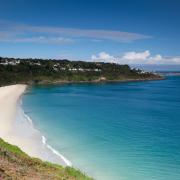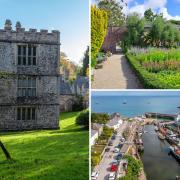As filming for a second series of Poldark gets underway we discover some of Cornwall's favourite Poldark spots

As soon as Ross Poldark cantered onto our screens across Bodmin Moor in the new BBC adaptation of Winston Graham’s novels it was clear that Cornwall would play a starring role. From shipwrecks in Gunwalloe to swimming at Porthgwarra, Poldark showcases theunsurpassedbeauty ofCornwall. Meet some of the stars...
Used as the location for the famous swimming scene, Porthgwarra provides some of the most picturesque scenery for the new Poldark series. Less than two miles from the Minack Theatre, Porthgwarra is a small cove and fishing hamlet within an Area of Outstanding Natural Beauty in the far west of the county. Owned by the St Aubyn Estate, the steep working slipway runs down to a narrow sandy beach at low tide. The sheltered cove and clear water is perfect for swimming, although strong currents run beyond the headland. As the most remote of the Poldark locations, it has just one seasonal café.
Porthgwarra has its own history to explore with two tunnels cut through the rock. Dug by tin miners, the largest tunnel provided cart access to the beach for locals to collect seaweed for fertiliser. A second tunnel leads to the fishermen’s tidal hulleys (pools), used to keep shellfish fresh before market. Above the cove the granite cliffs of Gwenapp Head formed the dramatic backdrop for the flash-back encounters between Ross and Elizabeth.
Part of a World Heritage Site, Grade II listed Charlestown Harbour posed as Poldark’s Truro. With a unique collection of Tall Ships and original granite quays, the inner and outer harbours provide the perfect film location.

Situated on the outskirts of St Austell, Charlestown took its name from landowner Charles Rashleigh. He developed the harbour between 1790 and 1810 as a Georgian new town’ to support the fishing and china clay industries. Charlestown remains a working harbour for china clay exports. Now owned by Square Sail, Charlestown regularly hosts TV and film crews for maritime scenes in the controlled film tank of the inner harbour. The village boasts the Charlestown Shipwreck & Heritage Centre (shipwreckcharlestown.com) with a Titanic collection and an impressive range of exhibitions on local history, shipwrecks and the china clay industry.
Wild and untamed, Bodmin Moor reflects Ross’s character. The exterior for Poldark’s rustic and somewhat dilapidated house, Nampara, was filmed near St Breward on the moor.
Minions near to the Hurlers Stones provided the crossroads, which feature in many horseback scenes between Nampara and Trenwith. The sea was superimposed into the background for the TV series.
This is wonderful walking country, with the tors offering more isolation than the coastal footpath. Granite outcrops, standing stones and signs of prehistoric settlement fill Bodmin Moor with myths and mystery. In addition to Poldark, Bodmin Moor has many links to legends and literature from Daphne du Maurier’s Jamaica Inn and Dozmary Pool from the Arthurian legends. The highest point on the moor, known as Brown Willy, lies at 420m above sea level.

Shipwrecks and beach fires made for dramatic scenes at Church Cove, Gunwalloe. Filmed at night, Aidan Turner and many extras set out with torches and fires to recreate Winston Graham’s shipwreck. Out on the beautiful Lizard Peninsula, this sandy beach is perfect for families. The north end of the beach is of particular interest due to the small church of St Wynwallow, which sits under the cliffs and gave the beach its name.
As part of the first entry in the Domesday Book, Gunwalloe’s history stretches back far beyond Poldark’s 18th century. The church was rebuilt in the 14th and 15th centuries but the bell tower belongs to an earlier manifestation and remains separate from the main building. Popular with surfers and swimmers, there is a National Trust car park at Church Cove with refreshments in the summer.
The BBC made the most of Cornwall’s rich mining history, using the striking engine houses along the coast of West Cornwall for Poldark’s mining endeavours. Owles and Crowns near Botallack has a spectacular position overlooking the sea and plays the part of Ross’s Wheal Leisure. The National Trust’s Levant Mine doubles as Tressiders Rolling Mill and houses a unique steam-powered Cornish beam engine that is still in action today.
Between St Just and Pendeen the coastal path is lined with mine shafts and engine houses. Botallack was awarded UNESCO World Heritage Status in 2006 as part of the Cornish Mining World Heritage Site. You can still see the 19th century copper-dressing floors where copper ore was separated from waste rock, mainly by women and children.
This article first appeared in Cornwall Life May 2015



























